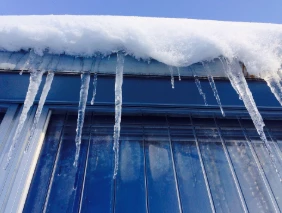Cold Weather Checklist

Dangerously cold weather has arrived. Are you finding out just how drafty your home really is? If yours is like the average home, the total amount of air leaks from top to bottom allows the same amount of cold air to enter as leaving one window wide open! That’s definitely not energy efficient!

Fortunately, you don’t have to sit there knowing you’re paying more to heat your home than necessary. All it takes to seal the most prominent holes in your home’s outer envelope is a little caulk, weather stripping and maybe some expanding spray foam. Follow this cold weather checklist to save money and keep the cold out this winter.
Finding Sources of Air Leaks

Before you can plug a single air leak, you need to know where to look. There are dozens of places around your home where the air is probably leaking. Look in the following places:
- Windows and doors
- Plumbing penetrations
- Ductwork penetrations
- Recessed light fixtures
- Electrical outlets on exterior walls
- Baseboards
- Fans and exhaust vents
- Attic hatches
- Fireplace dampers
- Crawlspaces
Test for air leaks with these methods:
- Look for visual signs of leaks such as cracks or holes.
- Walk around your home at night. Have someone shine a flashlight around wall penetrations inside the home and see if you can see the light from outside. If so, there’s a leak.
- Feel for drafts, especially on windy days.
- Try to rattle windows and doors. If you can, there’s an air leak here.
- Light a candle and carry it around to the places listed above on a windy day. If the flame flickers excessively, there’s a leak.
Weather stripping Windows and Doors
Use this material to seal leaks around the moveable joints of windows and doors. Choose a type of weatherstripping that suits the application so friction, temperature changes, and moisture don’t deteriorate it. Also, note that weatherstripping comes in various widths and depths.
With the material selected, follow these application guidelines:
- Clean and dry the surface you plan to apply the weather stripping to. Wait until the temperature is above 20 degrees F outside before applying it.
- Measure twice before making a cut to avoid mistakes.
- Press the weather stripping firmly in place between the two surfaces. Test your application by opening and closing the window or door. If you applied it correctly, the material should compress and prevent the window or door from rattling.
Caulking Windows and Doors
Use caulk to plug up air leaks in a wide variety of fixed locations, including window and door frames. Select a caulking compound that has the appropriate strength and properties for the job.
At the time of application, follow these tips:
- Clean and dry the area you plan to caulk for lasting adhesion. Remove chipped paint or old caulk with a putty knife if necessary.
- Hold the applicator at a 45-degree angle to help the caulk seep down into the gap. If the opening is deep, make sure the caulk reaches the bottom so bubbles don’t form.
- Avoid stopping and starting so the caulking is applied in a continuous stream.
- Release the trigger early at the end of a continuous stream so you don’t accidentally apply too much. Scrape excess caulk away with a putty knife if necessary.
Sealing Other Air Leaks

You can use caulk to seal any gap measuring 1/4-inch wide or less. For larger gaps, you may need expanding spray foam. For some hard-to-reach air leaks, you may need the help of an HVAC technician.
For help air sealing your home, or for other advice to get your home ready for winter, please contact Aire Serv® today. Breathe. We’re here to help you find peace of mind with clean, comfortable air. Click to call
Click to call


